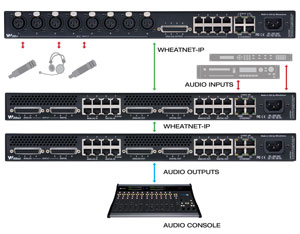WHEAT:NEWS TV Oct 2015 - Vol 2, No. 7
Got feedback or questions? Click my name below to send us an e-mail. You can also use the links below to follow us on popular social networking sites. The tabs at the very top of the page will take you to our web sites.
5 Surprising Places for IP Audio
Your IP audio network could be going places and doing things you might not be aware of, from remote sportscasts to hanging out in malls, at press conferences, and inside auditoriums.
Modern audio networks are being used for a slew of new applications because of newer, smarter I/O units. For example, WheatNet-IP BLADE-3s combine integrated control with audio tools such as mixing and audio processing at every connection point in the network for a multitude of uses.
It’s almost like having a complete IP audio studio in one rack unit you can use wherever you need one.
And with AES67 now promising to interface the audio network to just about any audio device out there, there’s no telling where IP audio will be off to next.
Here are just a few ways you can use your WheatNet-IP BLADE-3s:
 Audio in the Outfield: Quickly set up a small studio at any sports venue with audio routing, processing, mixing and logic controls of mics and other devices all in one rack unit. All you need is a BLADE-3 at the press box as your audio interface into your mics (16 mono channels) and a connection to the production truck or main studio.
Audio in the Outfield: Quickly set up a small studio at any sports venue with audio routing, processing, mixing and logic controls of mics and other devices all in one rack unit. All you need is a BLADE-3 at the press box as your audio interface into your mics (16 mono channels) and a connection to the production truck or main studio.
 Audio at the Press Conference: The same BLADE-3 you use for sporting events can be used for all those press events and speeches this political season. Simply interface it to your mics at the press conference and send audio feeds back to your truck or home studio over a connection. To take advantage of 5.8 GHz unlicensed wireless IP radios as a line-of-sight link to the truck or studio, simply add an EDGE unit. EDGE connects directly into the IP wireless radio through RJ-45 connectors to carry audio between locations.
Audio at the Press Conference: The same BLADE-3 you use for sporting events can be used for all those press events and speeches this political season. Simply interface it to your mics at the press conference and send audio feeds back to your truck or home studio over a connection. To take advantage of 5.8 GHz unlicensed wireless IP radios as a line-of-sight link to the truck or studio, simply add an EDGE unit. EDGE connects directly into the IP wireless radio through RJ-45 connectors to carry audio between locations.
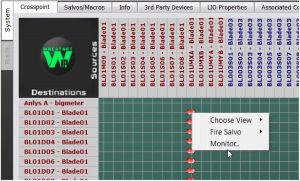 Audio Network as an IFB: Talk to talent over your IP audio network. Any WheatNet-IP BLADE access unit that routes audio also can provide the IFB pathway, whether it’s on location or in the studio; simply change crosspoints to create routable IFB throughout.
Audio Network as an IFB: Talk to talent over your IP audio network. Any WheatNet-IP BLADE access unit that routes audio also can provide the IFB pathway, whether it’s on location or in the studio; simply change crosspoints to create routable IFB throughout.
Transport audio between the auditorium and the production studio/truck using BLADEs at each end. Carry mic and instrument feeds from the stage area to the network over CAT6, wireless or optical fiber link. Do separate mixes live using the BLADE’s 8x2 stereo mixers, or capture multitrack recordings for future mixing. No transformer splits required!
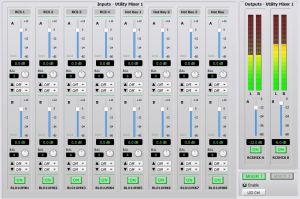 Audio for Multi-location Venues: Place BLADE I/O units in the van, on stages or throughout the field, and connect them together over fiber and CAT6 via the network switch for audio transport between them. Great for music festivals that require real-time communication between multiple stages.
Audio for Multi-location Venues: Place BLADE I/O units in the van, on stages or throughout the field, and connect them together over fiber and CAT6 via the network switch for audio transport between them. Great for music festivals that require real-time communication between multiple stages.
Can you think of other out-of-the-way places for IP audio networking? Email us at [email protected]
We Brought Home the Engineers' Gold this IBC Show!
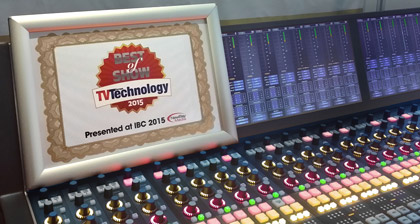 Wheatstone came home with a Best of Show award this IBC show for the Gibraltar IP Mix Engine, the first IP network interface for a new breed of audio consoles that provides never-before control and access throughout the studio.
Wheatstone came home with a Best of Show award this IBC show for the Gibraltar IP Mix Engine, the first IP network interface for a new breed of audio consoles that provides never-before control and access throughout the studio.
This recognition means so much to us because we know that the judges for NewBay’s IBC2015 Best of Show awards are industry experts and working engineers, like you. Only the best of the best are chosen – products that solve real problems, that can hold up to the demands of broadcasting, and that are innovative and cost effective.
Congratulations to our engineers who worked so hard to bring the Gibraltar IP Mix Engine to fruition and thanks to the industry we serve for recognizing all of our hard work.
Video: Associated Connections with WheatNet-IP for TV
Who's Buying Wheat: October, 2015

Wheatstone
-
- IMG College (Winston Salem, NC) purchased new I/O BLADEs and Screen Builder custom app to expand an existing WheatNet-IP audio network.
- Aphex Broadcasting (Hilton Head, SC) purchased two I/O BLADEs for a wireless STL application.
- MZ Media (Toronto, ON) purchased an I/O BLADE for an existing WheatNet-IP audio network.
- Corus (Calgary, AB) purchased LX-24 control surfaces.
- KTWN-FM (Minneapolis, MN) purchased NAVIGATOR 3 upgrade software.
- CBC (Moncton, NB) purchased audio drivers for an existing WheatNet-IP audio network.
- CJBQ-AM (Peterborough, ON) purchased an LX-24 control surface and audio drivers for a WheatNet-IP audio network.
- KFRG-FM (Colton, CA) purchased a high density LIO-48 BLADE and NAVIGATOR 3 upgrade software for an existing WheatNet-IP audio network.
- CBC (Inuvik, NT) purchased an I/O BLADE and Screen Builder custom app for an existing WheatNet-IP audio network.
- KERA-FM (Dallas, TX) purchased a BLADE and SBC turret for a WheatNet-IP audio network.
- Delmarva Broadcasting (Wilmington, DE) purchased a TS-4 talent station, IP-12 digital audio console and several I/O BLADEs.
- Gulf Coast State College (Panama City Beach, FL) purchased four E-1 control surfaces and I/O BLADEs.
- MediaWorks (Auckland, NZ) purchased a Screen Builder custom app.
- United Christian Broadcasters Ltd (Staffordshire, UK) purchased two LX-24 control surfaces and I/O BLADEs.
- City Colleges of Chicago (Illinois) purchased an LX-24 control surface through BSW.
- iHeartMedia (Richmond, VA) purchased an IP-16 digital audio console, M4-IP3 four channel mic processor and I/O BLADE.
- Austin Independent School District (Austin, TX) purchased an E-6 control surface.
- City of San Antonio (Texas) purchased two E-6 control surfaces through Beck TV.
- Leighton Broadcasting (St. Cloud, MN) purchased an M4-IP four channel mic processor and WheatNet-IP audio drivers.
- KCNC-TV (Denver, CO) purchased a Series Two audio console.
- Audio Design Company (China) purchased an IP-16 digital audio console for Radio Foshan, China.
- iHeartMedia’s WUSQ-FM (Winchester, VA) purchased an L-12 control surface, four M2 dual channel mic processors and WheatNet-IP I/O BLADEs.
- WXXI-FM (Rochester, NY) purchased a MADI interface for a TDM Gibraltar routing system.
- Sirius XM (New York, NY) purchased several GP panels.
Audioarts Engineering
-
- Real Presence Radio (Moorhead, MN) purchased an R-55e console.
- Alpha Media’s WXCL-FM (Peoria, IL) purchased an R-55e console.
- Grupo Media (Mexico City) purchased an R-55e console.
- Broadcast World Philippines (Manila) purchased an Air-4 console for GMA Radio Network.
- WKIL Radio (Galesburg, IL) purchased an Air-1 console.
- KUYY-FM (Keams Canyon, AZ) purchased an Air-1 console.
- WLTB-FM (Binghamton, NY) purchased an R-55e console.
- MMV (Montreal, QC) purchased an R-55e console.
Wheatstone Audio Processing
-
- Entercom (Kansas City, MO) purchased an M2 dual channel mic processor.
- Beasley’s WNCT-FM (Greenville, NC) purchased an AirAura spectral audio processor.
- Entercom (Wichita, KS) purchased a VP-8IP multi-mode audio processor.
- Townsquare Media (Tuscaloosa, AL) purchased an FM-55 audio processor.
- Radikal Elektronik Ltd (Turkey) purchased an M1 mic processor for Power Group, Istanbul, Turkey.
- Audio Solution (Taipei, Taiwan) purchased an AirAura spectral audio processor.
- ESPN (Chicago, IL) purchased five M2 dual channel mic processors.
- City Colleges of Chicago (Illinois) purchased seven M2 dual channel mic processors through BSW.
- Leighton Broadcasting (St. Cloud, MN) purchased an AirAura spectral audio processor.
Useful Links: October 2015
If the public only knew! What a sound engineer really does.
Women. Farming. Africa. Radio. Who knew? (Not existing anymore)
EVS’ Stellpflug Talks At-Home
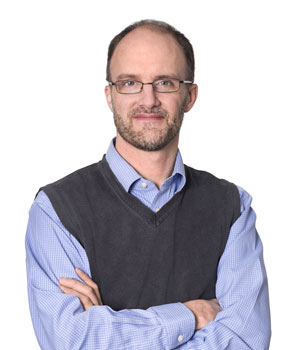 When the industry’s frontrunner in IP video transport starts making waves about a new workflow for live production, you tend to pay attention.
When the industry’s frontrunner in IP video transport starts making waves about a new workflow for live production, you tend to pay attention.
In our discussion with James Stellpflug, VP of Product Marketing for EVS, we get a much better picture of what’s behind the at-home or new evolutions in live event connected trends and what broadcasters should be thinking about when it comes to capturing and producing content in volume.
WS: “At-home” production seems to be on everyone’s mind lately. What do you make of this new workflow?
JS: Just about everyone is trying to solve the problem of how to generate more content, meaning doing more live production for sporting events, live entertainment, etc. One of the ways to do that is to bring some of the production staff back home, or to the broadcast center, and try to do more volume with that same crew and also to get more consistent production. That’s a very real solution.
WS: There are a lot of changes driving this, obviously.
JS: Yea. I don’t have the exact market data, but if we look out over the last decade or two, we can see that there’s this explosion in consumer devices. Traditionally the only way you could see a live event was to be sitting in front of a TV that had a hard wire on it through a cable system or off air. Now you’re seeing consumers with devices wherever they go. Their ability to access content right there at their fingertips has changed the way they think about content. Consumers seem to like more bite sized content, rather than the linear form. They’re not only streaming the entire broadcast, they want to consume bite-sized chunks when they have a pause in life.
WS: So how is this all playing out in terms of broadcasting?
JS: We’ve seen this evolution in the last decade where they started out doing a linear broadcast production, then they’d create their highlights for the linear storytelling, and then we saw smaller synopses to websites and other things. And now that’s picking up steam year over year, so it’s not linear, it’s a logarithmic growth (in producing content)….where they’re not having to make just one content for their website, they’re making multiple renditions. They’re now having to make subsets of a content, which allows consumers to personalize the content themselves depending on who is looking at it. If you have one fan log in (to the website) who likes a certain team, he could actually see a set of content that would reflect his personal desires rather than see static content groomed by a producer that is for the entire audience base. You’re just starting to see this hyper-individual content that can also be monetized different ways, like linking it to sponsors or paid tiers.
WS: How does audio fit into this? As you know, we’ve long established IP audio in radio, whereas TV broadcast is fairly new to IP.
JS: I’ve been on the fringe of audio for two decades. We’ve seen for a while now that radio has adopted this model where they were doing voice overs from the home or where different radio shows take place away from the studio because they had adopted IP. It’s just been the last seven to eight years that video has started to catch up to that production trend. If you go one step deeper into the infrastructure itself, radio has embraced IP for moving audio around, for a while now. The same problems this industry went through are now manifesting on the video side. We still need a unifying standard similar to AES67.
WS: Do you see standards happening similar to AES67 on the video side? (AES67 is an audio IP transport interoperability standard).
JS: I think so. SMPTE 2022 is probably the closest parallel right now. It’s a first step of making an open interoperable standard that all the manufacturers can adopt to bring us into that realm. But just as it is with AES67, we’re missing certain pieces that are needed to meet all of the functionality of today’s production.
WS: What’s missing in IP video standards?
JS: Well, 2022 is basically taking the world from an SDI video domain and encapsulating it holistically into the pipe. Which means we’re moving into an IP infrastructure with this standard, and that’s good. But we’re not being as efficient with it as we should be. We’re moving a lot of excess stuff around that we don’t need at all, and in other cases, where we don’t need at all times. If I were to deliver a SMPTE 2022 flow toward a Wheatstone audio console, for example, the console probably doesn’t care about the video object and in that case it’s a lot of wasted bandwidth. So when we look at this realistically, we are still missing the ability to do separate flows. If I need just a data object or audio object or video object, I shouldn’t have to move all of it in one wrapped up bundle and that’s what’s missing in standards as of yet.
WS: Just one final question, this one on 4K. Why are 4K and IP so tightly linked?
JS: For us, 4K is an emerging standard. We call it ultra HD. We’ve been recording it for years now through our production servers using what’s called QUAD-HD, or four SDI signals to accommodate the total payload of an ultra 4K signal. We recognize that today it is used as a production tool and if you want to do 4K today, it’s possible. But we also recognize that moving signals with four wires per signal is not practical. That’s a main driver for why we need IP. IP gives us a mechanism that is useful, whether I’m working in standard ultra HD or beyond. As long as I can packetize it, my infrastructure doesn’t have to change. That’s the advantage of an IP facility. Whereas today, when we look at it from the lens and view of an SDI plant, that’s been our problem in the course of the last two or three decades. Every time we’ve had a new video standard, that means we’ve had to replace the video cabling, replace the video patch panels, replace all the touchpoints – all the places it touches has to be replaced holistically because of a new standard. When you look at the IP industry and what we can leverage, it means we may not have to replace all the pieces. It might mean we have to replace a couple of chunks because we’re moving more bandwidth, but it doesn’t mean we have to change out each and every piece and the core technology itself.
WS: Thanks, James


